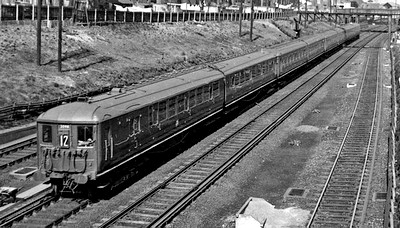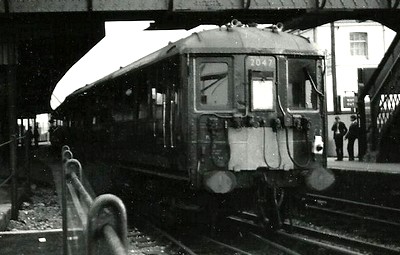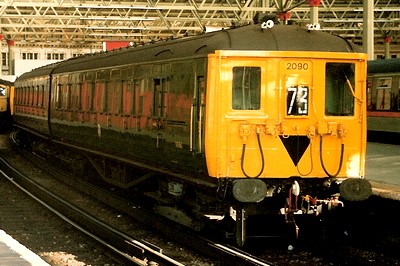
Clapham Junction, 1958 (Ben
Brooksbank)

Newhaven Harbour, 1965 (Hugh
Llewelyn)

London Waterloo, 1986
(Michael Day)
|
|
Designated "2BIL"
by the SR because each set had two lavatories,
one in each car, a total number of 152 sets were
eventually built. Whilst a two car unit was just
under 130 ft in length, the 2BIL were often
operated in 4 car formations and even up to 12
cars for London commuter services. With the
execption of four units destroyed during World
War 2 the 2BIL were used as of 1956 as
replacements on services previously covered by
2NOL ("no lavatories") and increasingly
mixed together with 2HAL units during the early
1960s.
As
of 1957 units started to feature the then new
style circular BR carriage crest logo which
replaced the "stretched lion" crest. In
1964 BR(S) began to apply small yellow warning
panels to the cab ends; between 1967 and 1970 a
number of 2BIL were repainted in overall BR
corporate blue with full yellow cab ends.
However, when the first units were withdrawn in
1970 many were still wearing BR green.
Replaced
by newly introduced 4VEP and 4CIG and transfers
of 2HAP units, the 2BIL saw their final services
on coastal trains out of Brighton. Final
withdrawal from service came in 1971, and all but
one unit were scrapped. The sole survivor, 2090,
was specifically put aside for inclusion in the
national collection of the NRM in York.
As
an oddity, the 2BIL were allocated the class
number 401 by BR as part of the TOPS system in
1972 - at a time when all units had already been
withdrawn for disposal, so that no 2BIL ever
carried the class number 401 in service.
The
pictures here show the 2BIL in all-over BR green
(top), carrying a yellow warning panel (center),
and with full yellow cab ends (bottom) in the
livery it carried for several railtours between
1986 and 1988.
Preserved
unit 2090 spent an extended period of time on its
home metals either running on railtours or (most
often) in storage. It was moved to York for full
restoration work in 2003 before moving to the NRM
outpost at Shildon (County Durham) where it is
currently on display, albeit a very long way from
home.
|

